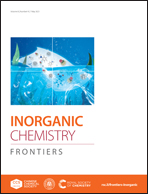Improving proton conduction of the Prussian blue analogue Cu3[Co(CN)6]2·nH2O at low humidity by forming hydrogel composites†
Abstract
In this study, we have synthesized Prussian blue analogue nanocrystals of copper hexacyanocobaltate (CuHCC), and their derivatives via a facile stepwise encapsulation of 1,3-diaza-2,4-cyclopentadiene (Im; Im@CuHCC) and acetic acid (HAc; Im-HAc@CuHCC) into the CuHCC framework. These materials were characterized by powder X-ray diffraction, thermogravimetric analysis, infrared spectroscopy, N2 adsorption/desorption and scanning electron microscopy. Im-HAc@CuHCC shows humidity dependent proton conduction with conductivity (σ) in the 0.933–8.55 × 10−2 S cm−1 range at 98% relative humidity (RH) while σ ≈ 10−6–10−5 S cm−1 at 25% RH in the 298–353 K range. We further prepared and characterized a series of composites of Im-HAc@CuHCC with a polyvinyl alcohol (PVA) hydrogel, labeled Im-HAc@CuHCC-PVA-X (X = 0, 2, 5 and 10%, and represents the mass ratio of Im-HAc@CuHCC and the hydrogel). Regarding PVA hydrogel, the tensile strength of composites is enhanced at least 1.5 times. Importantly, the X = 10% composite shows superior proton conduction with σ = 0.81–6.5 × 10−2 S cm−1 at 25% RH in the 298–353 K range, confirming that the formation of the hydrogel composite is a facile but efficient strategy to enhance the water-retention capacity and proton conduction at low humidity for porous proton conductors.
![Graphical abstract: Improving proton conduction of the Prussian blue analogue Cu3[Co(CN)6]2·nH2O at low humidity by forming hydrogel composites](/en/Image/Get?imageInfo.ImageType=GA&imageInfo.ImageIdentifier.ManuscriptID=D1QI00070E&imageInfo.ImageIdentifier.Year=2021)


 Please wait while we load your content...
Please wait while we load your content...